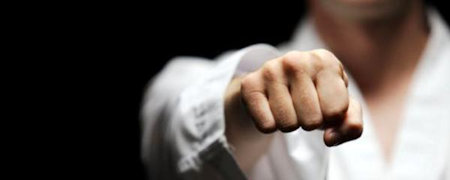Karaté - Budo |
|||
Eléments essentiels à la compréhension du karaté |
|||
 |
|||
A Selection of Sensitive or Dangerous Spots |
|||
|
All these points must be avoided during training or in competitions. Nevertheless, it is important to bear them in mind and work on them with perfect control, as they may be useful when faced with a stronger adversary in a real self-defence situation. 1.Head Eyes: the primary aim is to blind the opponent, even if for only a few seconds, in order to launch attacks. But beware: strong pressure on the eyeballs can cause irreversible damage as well as a drop in heart rate and blood pressure. Temples: the squamous part of the temple is the thinnest bone in the skull. A perpendicular strike can result in a depressed fracture of the skull. Nose: the bones in the nose are relatively thin and are only attached to the skull by their rear edges. A perpendicular strike to the nasal bones causes a sharp pain and often results in a fracture accompanied by a disabling nosebleed for the remainder of the fight. Tip of the chin: a circular strike (e.g. mawashi geri or mawashi tsuki) to the tip of the chin causes a rapid rotation of the head. The brain, located inside the cranium, has a certain inertia and is struck by the skull bones. This concussion of the brain can lead to a loss of consciousness, a subdural hematoma by pulling the vessels at the periphery of the brain or an intraparenchymal haemorrhage
2. Neck Mandibular angle region: upward pressure on the submandibular angle or horizontal pressure between the ear lobe and the bottom of the ascending branch of the mandible causes discomfort, probably through pressure on the pharynx and the branches of the facial nerve. At the submandibular angle we find the carotid bifurcation with its glomus, a kind of baroreceptor that measures arterial pressure. A strong impact or strong bilateral pressure on the glomus (using a blood choke) is incorrectly interpreted as a rise in blood pressure. This results in a reflex drop in heart rate and blood pressure. Larynx and trachea: impact, simple pressure simple or constriction cause discomfort and breathing difficulties. Be careful: increased pressure on the anterior surface of the trachea or larynx can cause severe damage or even choking. Nape: pressure applied with the distal end of two or three fingers on the middle and upper part of the nape just under the occipital bone causes pain by compressing the ligamentous structures between the spinous processes. This pressure often helps to control the opponent before striking a blow or carrying out a throw. Neck lock: if you apply one hand to your opponent’s chin and the other to the back of the skull, you can twist the head by applying pressure to the right on the chin and by pulling to the left on the back of the skull. This highly dangerous manoeuvre may cause serious damage to the cervical spine: ligament tears, disc lesions and vertebral dislocations and, secondarily, damage to the spinal cord.
Read more on the thorax, the abdomen and lower limbs in the book "Karate: more than the move" ...
6. Upper limbs Shoulder, elbow, wrist and finger locks. Locks can be performed on all limb joints. It is simply a question of applying a force that is greater than the joint’s capacity for extension or flexion. Pressure is exerted on or near the joint, with a second pressure applied in the opposite direction, away from the joint, to create maximum leverage. This manoeuvre may result in a torn ligament, a dislocation and sometimes a fracture. Deltopectoral groove: a slight upward pressure on the external side of the deltopectoral groove causes a painful compression of the distal end of the clavicle. The median nerve can be compressed at various points: the bottom third of the inside groove between the biceps and brachialis on the inner side of the front face of the elbow (near the brachial artery) and on the median part of the front face of the wrist. The radial nerve becomes superficial on the outer edge of the biceps muscle a few centimetres above the elbow crease and superficially downwards to the outer side of the front face of the elbow. Pressure applied to these two areas can result in sharp pain. Inner olecranon gutter: located on the inner, rear side of the elbow, an impact here causes a sharp pain by compressing the ulnar nerve. Metacarpals and fingers: a strike in a direction perpendicular to the shaft of the metacarpals or phalanges causes a pain that can be useful for extricating yourself from a hold or for dissuading your assailant from mounting a new attack. A fracture is possible, especially if the hand cannot move backwards when it is struck.
|
|||
| Informations on the book >>> | |||
| Budo editions >>> | |||